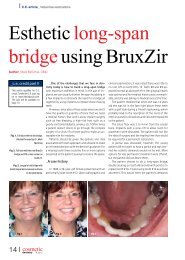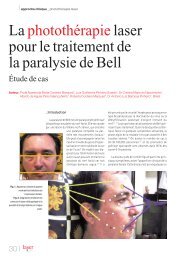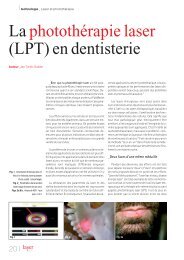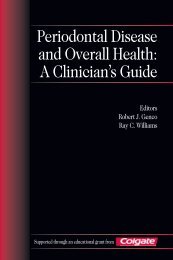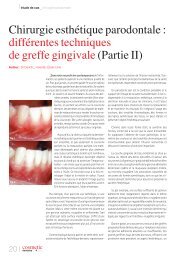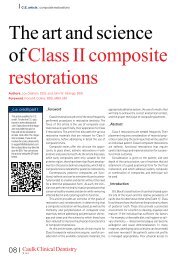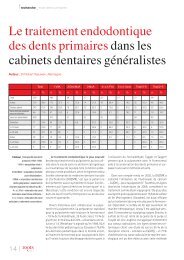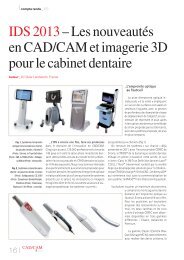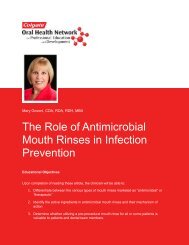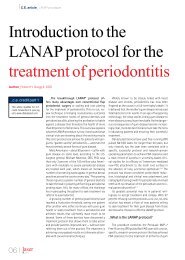Periodontal Disease and Overall Health: A Clinician's Guide
Periodontal Disease and Overall Health: A Clinician's Guide
Periodontal Disease and Overall Health: A Clinician's Guide
Create successful ePaper yourself
Turn your PDF publications into a flip-book with our unique Google optimized e-Paper software.
CHAPTER 2 Overview of <strong>Periodontal</strong> <strong>Disease</strong>:CHAPTER 2 Causes, Pathogenesis, <strong>and</strong> Characteristics 9active inflammatory cells producing highlevels of cytokines <strong>and</strong> enzymes causingrapid, aggressive destruction of periodontaltissues. Aggressive periodontitis can be furthercharacterized as localized <strong>and</strong> generalizedforms. The localized form usuallyaffects first molar <strong>and</strong> incisor sites. The generalizedform usually involves at least threeteeth other than first molars <strong>and</strong> incisors.Periodontitis as a Manifestationof Systemic <strong>Disease</strong>sSystemic conditions such as diabetesare associated with this form of periodontitis.16 Several hematologic <strong>and</strong> genetic disordershave also been associated with the developmentof periodontitis such as acquired,familial, <strong>and</strong> cyclic neutropenias, leukemias,Down’s syndrome, certain types of Ehlers-Danlos syndrome, Papillon-Lefevre syndrome,Cohen syndrome, <strong>and</strong> hypophospha -tasia. The mechanisms by which all of thesedisorders affect the health of the periodontiumare not fully understood <strong>and</strong> continue tobe investigated by many basic <strong>and</strong> clinical researchers.It is speculated that these diseasescan alter host defense mechanisms <strong>and</strong> upregulateinflammatory responses, resultingin progressive periodontal destruction.Necrotizing <strong>Periodontal</strong> <strong>Disease</strong>sThese lesions are most commonly observedin individuals with systemic conditions,such as human immunodeficiency virusinfection, malnutrition, <strong>and</strong> immunosuppression.Necrotizing periodontal diseasesare further divided into two forms: necrotizingulcerative gingivitis (NUG) <strong>and</strong> necrotizingulcerative periodontitis (NUP). Thesetwo diseases have the same etiology <strong>and</strong>clinical signs, except NUP involves clinicalattachment <strong>and</strong> alveolar bone loss. 17Abscesses of the Periodontium<strong>Periodontal</strong> abscess is a localized purulentinfection of the periodontal tissues. 18<strong>Periodontal</strong> abscesses usually develop inperiodontitis patients who may have fooddebris lodged in a pocket, or deep depositsof calculus where drainage from a pocketbecomes blocked. Iatrogenic abscess formationcan be precipitated after inadequate scaling<strong>and</strong> root planing, leading to a tighteningof the coronal epithelial cuff with continuedsubgingival calculus driving inflammation.Abscesses can also occur in healthy periodontaltissues due to the presence of foreignobjects lodged in the gingival crevice, suchas a toothbrush bristle or a popcorn kernelbeing tightly packed into the interproximalspaces or between the tooth <strong>and</strong> the tissues.A pericoronal abscess is an infection of thegingiva around a partially erupted tooth leadingto pericoronitis. A small flap of tissuemay cover a partially erupted tooth surface,serving as a nidus for food <strong>and</strong> debris to accumulate<strong>and</strong> become trapped beneath thetissue flap. Patients usually find it very difficultto keep these areas clean, <strong>and</strong> can developinflammation <strong>and</strong> infection. In addition,trauma due to constant contact betweenthe tissue flap <strong>and</strong> a tooth in the opposingarch can also lead to a pericoronal abscess.The areas most commonly affected are associatedwith m<strong>and</strong>ibular third molars. Pain,swelling, redness, <strong>and</strong> suppuration are associatedwith periodontal abscess. Treatmentmay include incision <strong>and</strong> drainage, use ofantibiotics, <strong>and</strong> removal of the offendingsource.EPIDEMIOLOGY ANDRISK FACTORSEpidemiology of GingivitisGingivitis can occur in early childhood,becomes more prevalent during teenageyears, <strong>and</strong> decreases in older individuals. 19 In1986-1987, the National Institute of DentalResearch conducted a nationwide survey oforal health in US school children 20 <strong>and</strong>reported that approximately 60% of chil -dren 14 to 17 years of age were found to



